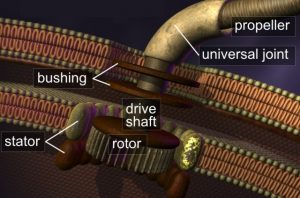Protein Machines – Part 6
 This month we turn our attention to a tiny little molecular machine that has become an icon of intelligent design, the bacteria flagellum. The single-celled E coli bacterium is so small that 10,000 can fit on the head of a pin. These rod-shaped cells move around through liquid by using an outboard engine called a flagellar motor. It is composed of 40 different proteins in an assembly that we recognize from building rotary motors. But this is an incredible engine that can run at 100,000 rpm at near-perfect efficiency. The motor can stop and reverse directions in a quarter of a turn. Even a tiny change in the machinery renders the motor inoperative and the bacterium “dead in the water.” So how can all these pieces come together by chance at once? Or how can another machine be gradually converted by evolution, bit by bit (while still functioning), into a sophisticated outboard motor like this?
This month we turn our attention to a tiny little molecular machine that has become an icon of intelligent design, the bacteria flagellum. The single-celled E coli bacterium is so small that 10,000 can fit on the head of a pin. These rod-shaped cells move around through liquid by using an outboard engine called a flagellar motor. It is composed of 40 different proteins in an assembly that we recognize from building rotary motors. But this is an incredible engine that can run at 100,000 rpm at near-perfect efficiency. The motor can stop and reverse directions in a quarter of a turn. Even a tiny change in the machinery renders the motor inoperative and the bacterium “dead in the water.” So how can all these pieces come together by chance at once? Or how can another machine be gradually converted by evolution, bit by bit (while still functioning), into a sophisticated outboard motor like this?
Posted on March 1, 2018 by dwoetzel.
